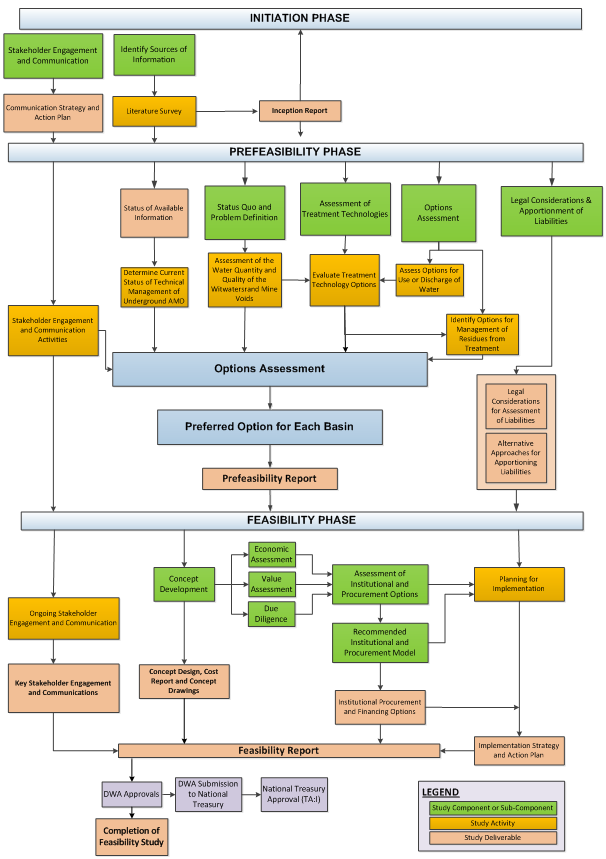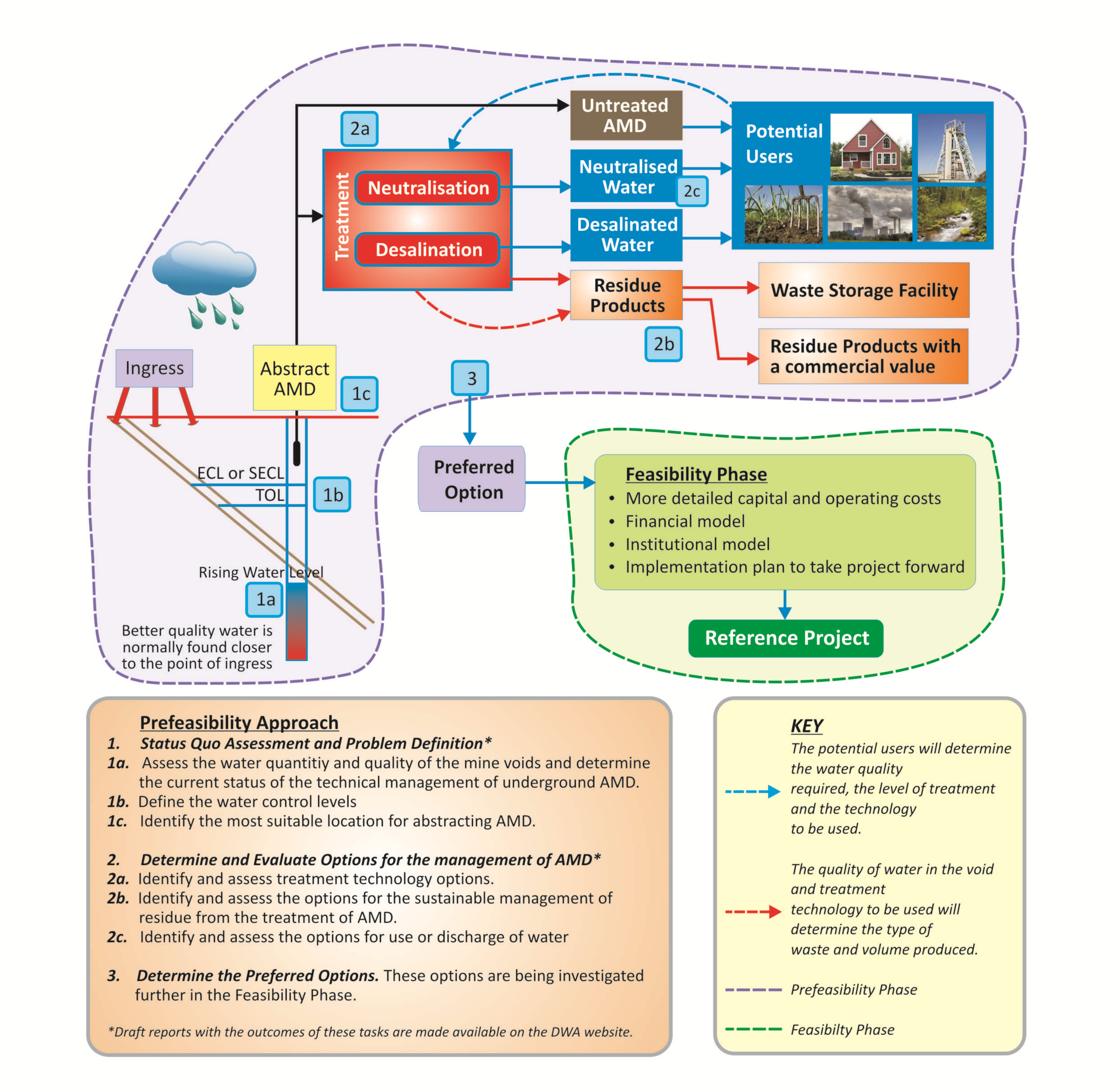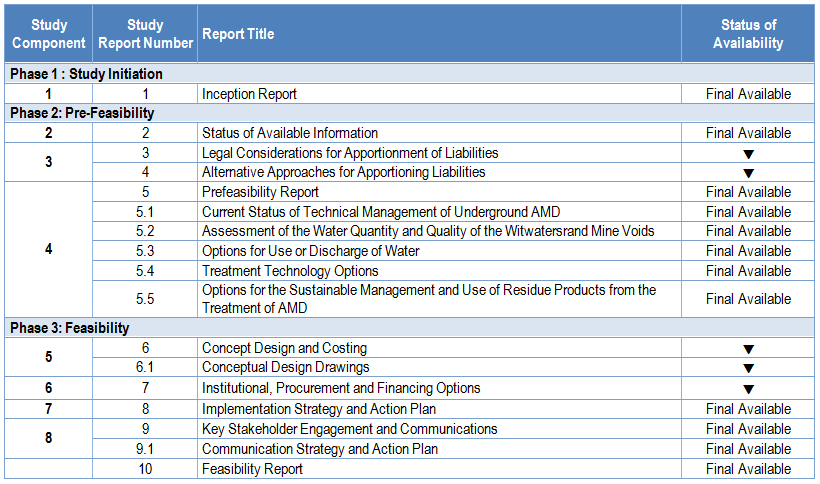|
STUDY APPROACH AND PROGRESS
AMD AND THE INTEGRATED MANAGEMENT OF THE VAAL RIVER SYSTEM
BACKGROUND
Since the publication of the first National Water Resource Strategy in 2004, the
Department of Water Affairs has embarked on a series of Reconciliation Strategy
Studies for all the large river systems supplying the metropolitan areas with
water. These studies developed future water requirement scenarios for each area
in close collaboration with the users, investigated methods to reduce the
demand, studied possible further resource development options (which included
accounting for the possible impact of climate change), and developed strategies
(including integrated water quality management strategies) to ensure continuing
supply of water for the next 25 – 30 years into the future.
Such a study was completed for the Vaal River Water Supply area
in 2009. It identified a number of core actions to ensure that sufficient water
is available to users in the future:
Apply all the necessary resources to eradicate extensive unlawful water use
as a matter of priority. Implement water conservation and water demand management measures to reduce
losses and reduce the urban demand by at least 15% by 2015. Implement the Vaal
River Integrated Water Quality Management Strategy. This has a focus on
salinity, eutrophication, microbiological pollution, and institutional
challenges. Undertake a feasibility study into the re-use of water, with first priority
being water from gold mines. Implement Phase 2 of the Lesotho Highlands Water Project by 2020.
This strategy was approved by the Top Management of the Department of Water
Affairs and the Minister at the time, and was also presented to Cabinet when
approval was obtained to proceed with the Lesotho Highlands Water Project (LHWP
Phase 2).
SALINISATION OF THE VAAL RIVER SYSTEM
Key contributors to salinisation of the integrated Vaal River System are sewage
return-flows, AMD and diffuse pollution (including atmospheric fall-out inter
alia associated with coal burning activities).
The ever-growing salt-loading of the Vaal River System has now reached the point
where steps need to be taken to limit and/or eliminate the sources of such
salt-loading. Addressing salinisation associated with AMD, has been prioritised
since it constitutes the most concentrated salt-stream.
Desalinisation of sewage return-flows and strict control of other sources of
salinisation are to follow.
However, mechanisms to recover the cost associated with the desalinisation of AMD
from all contributors to the salt-loading of the Vaal River System, and the
application of the Waste Discharge Charge System and tariffs on raw water use
need to be further investigated.
Further information on the impact of AMD on the Vaal River System can be accessed
at Documents Page

Graphs showing the estimated salt contribution as 1) a percentage of the salts
reporting to the Vaal Barrage and 2) the concentration of salts entering the
Vaal Barrage Catchment. AMD presents the most concentrated stream. These values
represent the salts received by the Vaal Barrage under a “Short-Term
Intervention” scenario, i.e. pumping and semi-treatment without significant
salts removal (based on historic data: October 1995 to September 2004).
A FEASIBILITY STUDY TO DETERMINE A SUSTIANABLE LONG TERM SOLUTION TO AMD
IN THE EAST, CENTRAL AND WEST RAND UNDERGROUND MINING BASINS
Addressing AMD in the East, Central and West Rand underground mining basins will
take place through a phased approach and consideration will be given to both the
need for short-term emergency interventions and the requirement for the
implementation of a long-term sustainable solution.
The focus of the Short-Term Interventions (STI) is to protect the Environmental
Critical Level (ECL) (See
Newsletter 2 – for an explanation of the ECL) as a matter of urgency,
whereas the focus of the Feasibility Study was to assess the options for a
sustainable long-term solution that will contribute towards water supply
security. Planning investigations aimed at informed decision making, are usually
conducted at 3 levels i.e.:
The reconnaissance level; The prefeasibility level; and The feasibility level.
The AMD Long-Term Solution Feasibility Study contained elements of all 3 levels
and was structured as follows:

Phase 1: Initiation
Inception Phase:
The objective of the Initiation Phase was to determine the approach and
principles for the Study and understand the work already done by others (see the
Edition 1 Newsletter for more information). Numerous reports from previous
studies, maps and research findings, relating to all components of the Study,
were collated and reviewed. The Scope of Work, proposed approach and the study
programme were reviewed after initial consideration of the available
information. The study objectives and priorities were reviewed and the results
are presented in Study Report No. 1: “Inception Report”.
Literature Review and determination of the status of Information:
The results of the complete literature survey, which continued after the
Initiation Phase, are presented in Study Report No. 2: “Status of Available
Information”.
Key Stakeholder Engagement and Public Communication:
The Study Report No. 9.1: “Communication Strategy and Action Plan” was prepared
so that key stakeholder engagement and communicators could commence as soon as
possible and continue throughout the Study.
Engagement with key stakeholders and public communication were very important
components of the Study and were on-going from the commencement of the Study to
the completion of the work. Study Stakeholder Committee meetings, Focus Group
meetings, a Request for Information, one-on-one meetings, newsletters and this
website were key elements. For further information on the communications part of
this study click on "AMD FS LTS Communications"

Phase 2: Prefeasibility
The purpose of this phase was to understand and describe the current status and
the environment for managing AMD and then to identify all apparently viable
alternative solutions and, from those, identify the more feasible options, on
the basis of technical feasibility, social and environmental acceptability and
cost effectiveness (see
the Edition 2 Newsletter for more information). The objectives of the Prefeasibility Phase were to:
Understand the status quo; Define the problem; Understand the quantity and quality of water in the mine voids and how fast is it rising in each basin; Identify possible uses for the water; Identify treatment technologies that can treat the necessary volumes of AMD to the standard required by various users; Understand the residues (or waste products) produced by each process and how they can be managed; Define a wide range of options for possible solutions by combining alternatives for abstraction, water use, treatment and management of residues; Screen the alternatives to identify viable options; and Carry out prefeasibility costing of the most viable options and identify the most appropriate option to be used as the Reference Project.
The knowledge and data from the Prefeasibility Phase were used to combine the
alternative locations for the abstraction, treatment and use or discharge of
water and the disposal of residue, as well as the layouts of the infrastructure
required (including pipelines and pump stations), into a large number of
options. The alternatives were screened at a high level to give a short-list of
practical technical options. These were then considered in more detail, and the
most feasible options were investigated in the Feasibility Phase. The results
and an overview of all the components of the Prefeasibility Phase are described
in Study Report No. 5: “Technical Prefeasibility Report”.
The figure below shows the “AMD life-cycle” and the key aspects of the complex
and multiple interdependent activities forming part of the Prefeasibility Phase
of the Study.

Phase 3: Feasibility
The main objective of this phase was to carry out intensive feasibility level
investigations and optimisation of the most feasible layouts for each basin and
to select a preferred option to be used as a Reference Project for each basin
(see the Edition 3 Newsletter for more information). The requirements for
implementation were also considered and evaluated.

The Feasibility Phase consisted of a number of components that were built on the
results of the Prefeasibility Phase; the results of the various components are
reported separately and then integrated in a Feasibility Report for the solution
to AMD.
The components in this Phase comprise of:
Concept Design and Costing: Once the Reference Project for each basin had
been agreed, the layout for the treatment works, pipelines and waste storage and
disposal sites was planned and costed. Environmental screening was undertaken
for each of the identified sites that form part of the Reference Project. The
results are presented in the confidential Study Report No. 6: “Concept Design
and Costing”
-
Institutional Procurement and Financing Options: The following alternative
procurement models for implementation were evaluated in more detail:
a ‘traditional’ Government-funded and a traditionally procured Employer Design, Procure, Construct and Operate solution, which is the Public Sector Comparator model (PSC); a Design, Build, Operate and Maintain (DBOM) scenario funded by an Implementing Agent, using Private Sector or Government funding, which is also a Public Sector Comparator model (PSC); and a private sector-funded Public–Private Partnership (PPP).
These assessments are described in the confidential Study Report No. 7:
“Institutional, Procurement and Financing Options”.
Implementation Strategy and Action Plan:
Throughout the Study, the requirements for implementation were considered in
developing an Implementation Plan. Where necessary, the activities required for
implementation that must commence in parallel with this Study were identified.
This included the preparation of a Request for Information (RfI), which
initiated a process through which service providers could register their
interest with DWA. All the requirements for implementation are described in
Study Report No. 8: “Implementation Strategy and Action Plan”.
The final deliverable, Study Report No. 10: “Feasibility Report”, summarises the
results of the Study.
SUMMARY OF STUDY DELIVERABLES
A list of the study deliverables is provided below. Reports for Phase 1 and
2 are available at documents page.
The reports for Phase 3 of the study are expected to be made available to the
public in due course, once the applicable departmental approval processes have
been concluded.

 These reports will not be made available until the appropriate implementation
process stages have been reached as they may potentially compromise future
procurement and legal processes. These reports will not be made available until the appropriate implementation
process stages have been reached as they may potentially compromise future
procurement and legal processes.

|